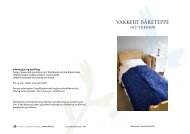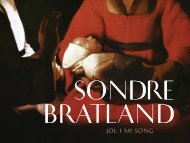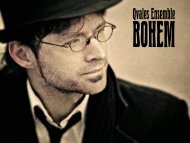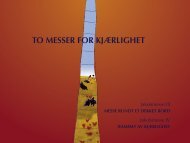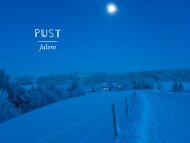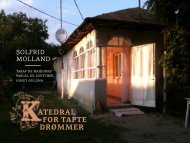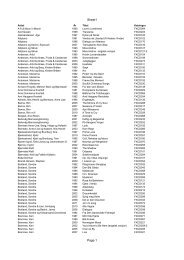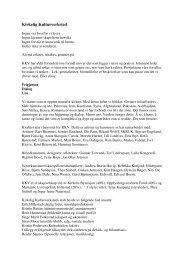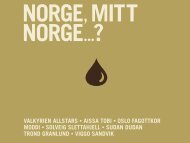Ferha t Tun ç - Kirkelig Kulturverksted
Ferha t Tun ç - Kirkelig Kulturverksted
Ferha t Tun ç - Kirkelig Kulturverksted
Create successful ePaper yourself
Turn your PDF publications into a flip-book with our unique Google optimized e-Paper software.
<strong>Ferha</strong>t <strong>Tun</strong>ç<br />
d e r s i m<br />
Kirmanciye Laments<br />
ŞUWARE KIRMANCİYE
language is the last shelter of<br />
communities in the face of<br />
extinction. People exiled from<br />
time, keep in their language<br />
the stories that have been dismissed<br />
by history “DERSIM<br />
Kirmanciye Laments” collected<br />
in this album carries<br />
the last cries of the land of<br />
Kirmanciya Beleke (Alacah-<br />
Elvan- Kirmanciye), which<br />
is also remembered as Dervish<br />
Land (Admission Land)<br />
It expresses the last cries of<br />
its dispersed people, the last<br />
laments resounding under the<br />
skies. Most of the laments in<br />
the album attempt to express<br />
the anonymous feelings<br />
during the 1938 slaughter,<br />
also called the Great Tertele<br />
(genocide). The laments we<br />
publish in Kurdish and English<br />
keep their secrets in their<br />
original language. They say<br />
that the mystery of a language<br />
is kept in the words<br />
that cannot be translated into<br />
other languages. If so, it is<br />
not the sound, but the ear<br />
that gives meaning to words.<br />
ferhat tunç
ferhat tunç is an artist in the singer-songwriter-tradition.<br />
He is famous in Turkey and<br />
many other countries with a long and remarkable<br />
career with numerous CDs in Turkish<br />
behind him. His mother tongue is Kurdish,<br />
however, and he has for a long time had a<br />
wish to release an album with Kurdish songs<br />
that tell the tragic story of the Kurds in Turkey,<br />
where tens of thousands were massacred in<br />
the 1930ties. Even today many laws limit the<br />
use of Kurdish culture in Turkey. The Kurdish<br />
population is a minority that has been under<br />
heavy pressure from Turkish nationalist governments<br />
since the breakdown of the Ottoman<br />
Empire around the First World War. In<br />
the Kurdish village Dersim the people rebelled<br />
against the Turkish resettlement laws of 1934.<br />
In the attacks on the village and their aftermath,<br />
between 50.000 and 80.000 people (the<br />
numbers are still being disputed) were murdered<br />
by the Turkish army in 1937 and 1938.<br />
<strong>Ferha</strong>t <strong>Tun</strong>ç has been sentenced to 6 weeks<br />
in prison for having performed Kurdish songs<br />
and talked about the Dersim massacre from<br />
a stage in East Turkey, and he has a series of<br />
court cases hanging over his head, because of<br />
his openhearted utterances about these topics.<br />
<strong>Ferha</strong>t <strong>Tun</strong>ç was granted the Freemuse Award<br />
in 2010 for his work for freedom of expression<br />
and the right to promote Kurdish culture<br />
and history in Turkey. Erik Hillestad
<strong>Ferha</strong>t <strong>Tun</strong>ç (vocals)<br />
Engin Arslan (saz, tambur)<br />
Ertan Tekin (duduk, mey)<br />
Knut Reiersrud (guitars, organ, bass)<br />
Rune Arnesen (drums, percussion)<br />
Choruses: Marian Lisland, Håkon Iversen, Per Øystein Sørensen,<br />
Jostein Hasselgård, Håvard Gryting<br />
Arranged by the musicians and <strong>Ferha</strong>t <strong>Tun</strong>ç<br />
under the leadership of Knut Reiersrud<br />
Arrangements for choruses: Marian Lisland<br />
Recorded in: Ada Stüdyo in Istanbul (instruments) • Nordraak Studio in Oslo<br />
(vocals and choruses) • Ösgur Öskan Mete (sound engineer in Istanbul) •<br />
Martin Abrahamsen (sound engineer in Oslo • Mixed by: Martin Abrahamsen<br />
Photos: Archive, Kalan Müzik- Hasan Saltık • Design: Geir Henriksen i Blæst Design • English translations<br />
for the cover: Betul Genc • English translations for the choruses: Erik Hillestad<br />
Thanks to: Cemal Taş, Hüseyin Ayrılmaz, Hewal Ali and Emirali Yağan,<br />
Mona E. Flognfeldt and Maria F. Jones<br />
Supported by: the Ministry of Foreign Affairs, Norway
1. wad bo 03:45<br />
2. Şuwara<br />
kirmanciyē 06:03<br />
3. govendia<br />
milaketo 04:43<br />
4. pithe me 04:45<br />
5. abaso 04:46<br />
6. ma Çhi di 04:30<br />
7. hewa sile suri 05:49<br />
8. hora hora 04:45<br />
9. Çuxure 03:55<br />
10. biko 05:06<br />
produced by Erik Hillestad • FXCD 378<br />
<strong>Kirkelig</strong> <strong>Kulturverksted</strong> 2012<br />
www.kkv.no
Sêyd Rıza • Dersim
Men of the Xêçe village are taken to be massacred. Almost all of the village population are made to leave their homes early in the morning of August 15,<br />
1938 accompanied by armed soldiers. They are all shot dead in the afternoon of the same day in Mount Beyaz in Hopik.
A group of women and children from the village of Hêce.<br />
“As division number 41 searched the west side of Munzur river for the men to be transported to the West, resistance was offered, and 395 outlaws from<br />
the villages of Zımbık, [Zımekê] Hiç, [Xêçe] Kırnik and Bornak were killed. The villages had been known to have assisted the outlaws.” Manoeuvre Journal<br />
of General Kazım Karabekir the commander of the 3rd Army Troops.
People retreated into mountains and forests to take refuge during the Dersim genocide. It was hard to carry kids and infants around. Kids who could not<br />
walk were thrown into rivers during some attacks. The young girls jumped hand in hand into the waters of the Rivers Munzur and Harçik, rather than<br />
being caught by soldiers. Babies were sometimes left under trees. Sometimes mothers were asked to strangle them. This song is the story of a mother<br />
and her baby who by crying endangered the lives of others.
Turkey participated in the Korean War of 1952, as a member of Nato. Abas from Dersim, was one of the soldiers who were sent to Korea. His tag was sent<br />
back to Dersim with a note saying that he was killed in a car crush. It is a tradition in Kırmanci culture to lament after an unexpected death or the death<br />
of a young one. This song tells the story of the death of a young soldier who lost his life at war.
This lament was inspired by the story of a mother who was forced to<br />
strangle her own child during the Dersim Genocide. Gewera Maçi conveys:<br />
“We retreated into the forest around the creek Pêtere. It was a dense<br />
jungle of century old oak trees. Getting out is difficult even for a snake.…<br />
Soldiers must have spotted our location from the smoke of the fire we lit<br />
at night. They surrounded us at dawn. A few armed men stayed with us to<br />
protect us, women and children. I was carrying my child. She was crying<br />
out of hunger, as there was no milk in my breast. The women were hungry<br />
too. I gave her my breast. She took it but there was no milk so she cried. I<br />
rocked her soothingly. Men told me to silence her. They said:<br />
“Give her milk, don’t let her cry. Look, soldiers are around us. They can<br />
spot us easily.”<br />
A woman pushed the baby’s head into my breast and pushed her mouth<br />
towards the nipple. She was squeezed between my arms and my breast.<br />
They did not let me move. She was breathless and stiff as wood in a few<br />
minutes. Her dead body lay in my arms. So... we have seen such things...<br />
If God is God, how can he let this pass?”<br />
Picture description<br />
Seyd Rıza’s house on the foothill of Thujik, a sacred mountain in Dersim.
Sılo Sur is one of the armed men of the Demenu tribe. He is a feared person<br />
among the tribesmen for his involvement in the fights between tribes before<br />
the genocide. He is famous for his courage and sharpshooting. He was killed<br />
in an ambush due to an internal tribe feud before the genocide. During the<br />
Dersim genocide those who gave up arms were shot dead and their bodies<br />
were thrown into the rivers. Other members of the tribe took refuge in the<br />
mountains, forests and caves. They were gassed and killed. Mother Saravane<br />
who sang the lament for her son reminds her tribespeople of her son and<br />
says: “If you had not cowardly killed my son, soldiers could not have settled<br />
on our land during the genocide of 1938.”<br />
Picture description<br />
The man standing in front of a tank with a rope around his neck, placed there<br />
by soldiers is Hesê Gêwe with some of his friends from the Demenu tribe.<br />
He was one of the resistance leaders of his tribe. Eyewitnesses have said that<br />
immediately after this Picture was taken he was interrogated by high level<br />
officers, tortured and killed.
River Harçig and valley. River Harçik has been the subject of many laments.<br />
It is said that the bodies of young brides and grooms some still<br />
holding one another were carried by the water for days on end. The sorrowful<br />
lyrics of the lamentation reflects the stories of Kamer Agha the<br />
leader of the Usıvu tribe who was sentenced to life imprisonment, his son<br />
Fındıq Agha who was executed and other family members who were shot<br />
dead and whose bodies were thrown into the river.<br />
“Sorrow, sorrow, sorrow it was<br />
The sorrow of this year has eaten away our hearts<br />
River, river, river Harçik<br />
You carry away the bodies of brides and grooms holding one another”
Çuxure is the village of the Alu tribe. Suli Agha, Hesen Agha and Memed<br />
Agha were brothers and prominent people of the tribe. Prime Minister of<br />
the time of the genocide, Celal Bayar visited village Çuxure. He refused the<br />
food offered to him. People of the village understood that he had hostile<br />
intentions. “If a guest refuses your offer, it is not a friendly affair anymore.”<br />
Soldiers took thirty villagers including elderly people and kids and made<br />
them walk for hours to Dersim’s Mazgirt province. Suli Agha realized that<br />
they would be executed and he made a wish to the commander:<br />
“Kill young girls and women before us”. The lamentation is dedicated to<br />
the family who were taken from their homes and never returned.<br />
Picture description<br />
Children of Ağlarê Çuxure who were students, in the year of the massacre.
The tree is called Merx in the local language of Kırmancki. It has three qualities. It is green in all four seasons. It is used to produce tambour. A bird plants<br />
it. The sound of the three stringed tambour made of Merx wood in Mount Bokıre is touching. Merx has fruits the size of chickpeas. It is edible. A kind of<br />
bird now facing extinction picks its fruit, eats the meaty bit and plants the seed. That seed grows into a Merx tree. As that kind of bird is facing extinction<br />
the Merx tree is facing extinction too in the land of Kırmanciye. Just as the Kırmanciye languages.
ferhat tunc and knut reiersrud<br />
in the studio in Istanbul<br />
View from the studio<br />
window in istanbul



